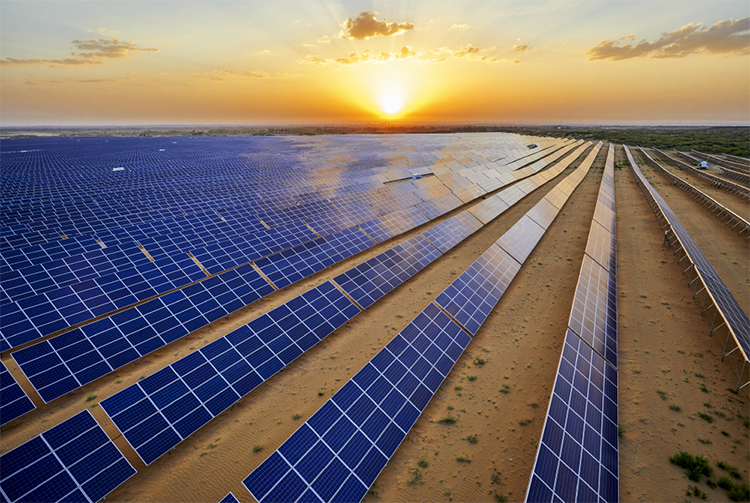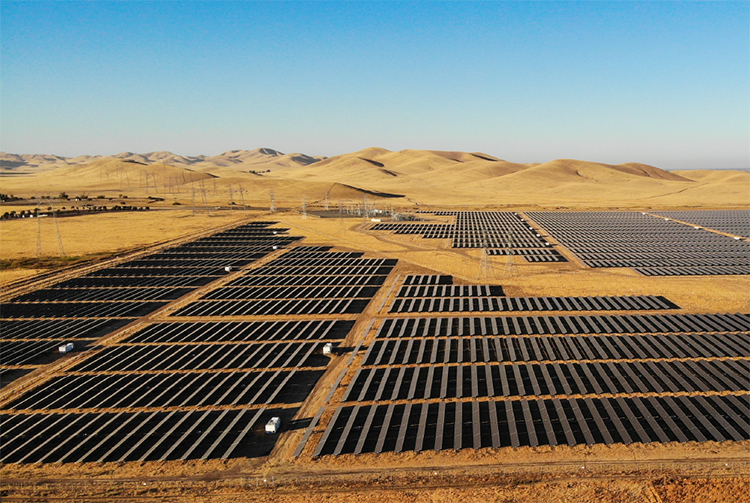The problem of desertification is getting worse due to human activity and the acceleration of global climate change. Fighting desertification brooks no delay, as China's desertified land area now stands at 2.62 million square kilometers, or 27.4% of the nation's total land area. How can one come up with a creative and efficient method of governance? Photovoltaic sand control emerged recently and has shown to be an effective method for controlling desertification in China as well as for the integration and development of new energy sources.

In light of globalization's efforts to combat climate change and advance environmentally friendly development, China is aggressively investigating novel approaches to curbing desertification. China's efforts to control desertification are increasingly relying on photovoltaic sand control, a governance model that blends the development of new energy sources with the prevention and management of desertification.
The construction of photovoltaic power plants in desert regions, coupled with the use of solar energy generation, is known as photovoltaic sand control. This technique fixes sandy soil, lessens sand invasion, and gradually restores the desert ecology. In addition, drought-resistant plants are planted and sand barriers are erected.
"In the context of 'double carbon', the new energy industry is booming and developing rapidly in the sandy areas." Sun Guoji, director of the Desertification Prevention and Control Department of the State Forestry and Grassland Bureau, stated at the inaugural meeting of the PV Sand Control Professional Committee of the China Society for Sand Control and Sand Industry on November 5, 2023, that PV sand control not only improves the ecological environment but also fosters the growth of new energy industries and realizes multiple win-win situations of social, economic, and ecological benefits.
The progress of photovoltaic sand control in China is noteworthy. China has been promoting photovoltaic sand management projects in desertification zones such as Inner Mongolia, Ningxia, Xinjiang, and other regions in order to reap the benefits of both clean energy and the environment. Of these, the PV sand control project in Inner Mongolia's Kubuqi Desert has grown to be the largest in the world, requiring a total investment of 5.5 billion yuan and producing an estimated 1 billion kWh of power annually, with the potential to fix 200,000 acres of sand.
Even though photovoltaic sand control has produced amazing results, there are still a lot of obstacles to overcome. "Sand control technology needs to be further improved, how to ensure the efficiency of photovoltaic power generation at the same time, effective governance of the desert, still need scientific research and study." Yang Wenbin, top expert in sand control at the China Academy of Forestry Research, stated. Furthermore, the photovoltaic sand control project encounters obstacles related to land, water resources, and other resources.
Several experts stated that there is still a lot of promise for photovoltaic sand control despite the challenges. The photovoltaic sand control project's economic benefits will materialize over time as photovoltaic technology advances and China's new energy policy continues to be refined.
"We put forward the slogan of 10 kilowatts of PV per person in the desert area, with the goal of creating a comprehensive pilot area of PV for ecological restoration and PV-enabled rural revitalization." He Jijiang, executive deputy director of the Tsinghua University Energy Transition and Social Development Research Center, was presented. With more light, less water, new technology, high efficiency, and industry benefits, "photovoltaic + composite utilization" is more for the desert area of the industrial development of the wings to take flight. This area has become the new choice for the desert.
As a cutting-edge technique for preventing desertification, photovoltaic sand control helps to improve the natural environment and foster the growth of the new energy sector. PV sand management will become more crucial in the future for China's efforts to combat desertification and generate new energy sources. PV sand control will show great promise in addressing climate change and advancing environmentally friendly growth.
Moving from "industrial sand control" into "ecological sand control"
Neatly organized solar panels, like a continuous "ocean" of flashing light in the expanse of the Gobi Desert, leave onlookers in awe of the perfect fusion of human intellect and the force of nature. This "ocean" appears to be an unbreakable "armor" constructed just for the earth, protecting the desert's ecological equilibrium.
The Gobi Desert and lush grass beneath the solar panels create a very different sight. Sheep were earlier unable to conceive the scene of them resting and grazing in this oasis, but thanks to photovoltaic sand control, it is now all possible.
The three northern regions of China include the majority of the country's desertified territory, which is closely linked to economically disadvantaged and minority-populated areas. More than 600,000 square kilometers of desertified land, or 23.3% of the country's overall desertified land area, are found in Inner Mongolia in particular. This makes up 51.5% of the autonomous region's entire area.
Water-saving irrigation and photovoltaic field stations to reduce wind and sand accumulation. The State Power Investment Beijing Dengkou I and II photovoltaic sand control project introduced photovoltaic sand control practices through a number of creative initiatives. "The Dengkou I and II PV sand control project treats 2,400 acres of sand, saves 45,000 tons of regular coal, lowers carbon dioxide emissions by 120,000 tons, and produces 120 million kWh of green power annually. It also lessens dusty weather by 10%. Together with the Dengkou County Government, we will construct Jinsha PV, a town designed to reduce poverty, promote the growth of regional enterprises, and address the issue of over 500 local jobs." Wang made the initial introduction.
In order to develop new strategies for sand prevention and control across the ocean and to continuously release new demonstrative effects, Dengkou practiced exploring the model of sand control.
2017 saw NDRC Beijing attend the Third United Nations Environment Assembly, which was hosted in Kenya at the recommendation of the National Development and Reform Commission. There, the Commission acknowledged the "Dengkou photovoltaic sand control model" as a keynote address. In 2022, the Dengkou three and four photovoltaic sand control projects were launched in an effort to gain more experience in solar sand control. In the field of developing new energy and ecological integration, the novel approach to sand and sand control model has been recognized. The Dengkou photovoltaic sand control project will enter its third and fourth phases in 2022, adding to its experience in solar sand control and advancing its ongoing efforts to build new energy ecological integration.
The photovoltaic sand control project in the Ulanbuh Desert has grown to a scale of 370,000 kilowatts, making it the largest, best-performing, and most standard example of the new energy ecological integration project in the region. It has also effectively brought about the shift from "sand in and people out" to "people in and sand out."

Not only does this "blue ocean" in the Gobi Desert provide clean electricity, but it also fosters unending hope. State Power Investment Corporation (SIPC) sustainable sand control model "desertification ecological management + green energy ecological industry" has continued to push integration of desertification control with new energy industry and high-quality development, as well as the shift from "industrial sand control" to "ecological sand control." "Ecological sand control" has replaced "industrial sand control."
"We will drive the transformation and upgrading of industries in desertified areas, build a sustainable industrial ecological chain, and strive to create a new miracle of China's sand control in the new era." Humans and nature coexist in harmony, and you may create a brighter future.







